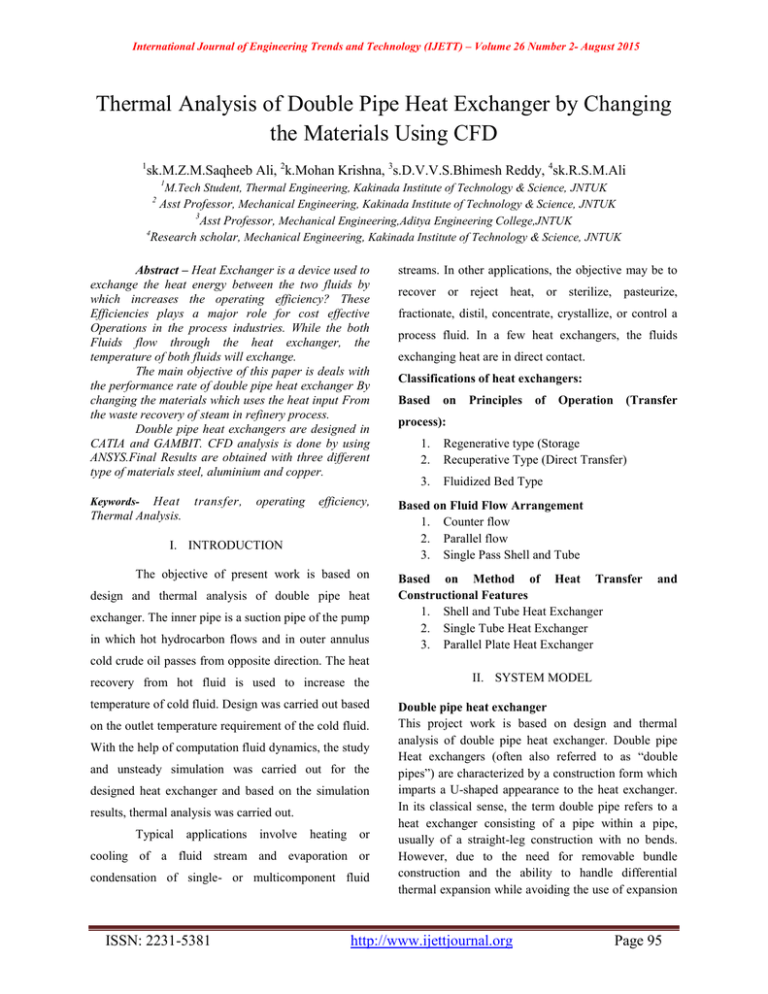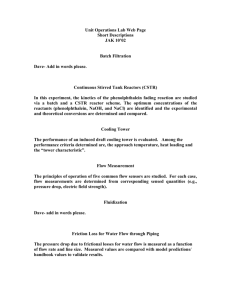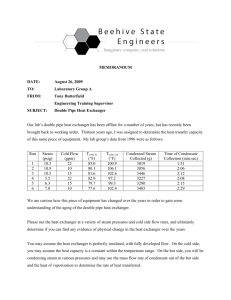Thermal Analysis of Double Pipe Heat Exchanger by Changing sk.M.Z.M.Saqheeb Ali,
advertisement

International Journal of Engineering Trends and Technology (IJETT) – Volume 26 Number 2- August 2015 Thermal Analysis of Double Pipe Heat Exchanger by Changing the Materials Using CFD 1 sk.M.Z.M.Saqheeb Ali, 2k.Mohan Krishna, 3s.D.V.V.S.Bhimesh Reddy, 4sk.R.S.M.Ali 1 M.Tech Student, Thermal Engineering, Kakinada Institute of Technology & Science, JNTUK Asst Professor, Mechanical Engineering, Kakinada Institute of Technology & Science, JNTUK 3 Asst Professor, Mechanical Engineering,Aditya Engineering College,JNTUK 4 Research scholar, Mechanical Engineering, Kakinada Institute of Technology & Science, JNTUK 2 Abstract – Heat Exchanger is a device used to exchange the heat energy between the two fluids by which increases the operating efficiency? These Efficiencies plays a major role for cost effective Operations in the process industries. While the both Fluids flow through the heat exchanger, the temperature of both fluids will exchange. The main objective of this paper is deals with the performance rate of double pipe heat exchanger By changing the materials which uses the heat input From the waste recovery of steam in refinery process. Double pipe heat exchangers are designed in CATIA and GAMBIT. CFD analysis is done by using ANSYS.Final Results are obtained with three different type of materials steel, aluminium and copper. streams. In other applications, the objective may be to Heat Thermal Analysis. Based on Fluid Flow Arrangement 1. Counter flow 2. Parallel flow 3. Single Pass Shell and Tube Keywords- transfer, operating efficiency, I. INTRODUCTION The objective of present work is based on design and thermal analysis of double pipe heat exchanger. The inner pipe is a suction pipe of the pump in which hot hydrocarbon flows and in outer annulus recover or reject heat, or sterilize, pasteurize, fractionate, distil, concentrate, crystallize, or control a process fluid. In a few heat exchangers, the fluids exchanging heat are in direct contact. Classifications of heat exchangers: Based on Principles of Operation (Transfer process): 1. 2. Regenerative type (Storage Recuperative Type (Direct Transfer) 3. Fluidized Bed Type Based on Method of Heat Transfer Constructional Features 1. Shell and Tube Heat Exchanger 2. Single Tube Heat Exchanger 3. Parallel Plate Heat Exchanger and cold crude oil passes from opposite direction. The heat recovery from hot fluid is used to increase the temperature of cold fluid. Design was carried out based on the outlet temperature requirement of the cold fluid. With the help of computation fluid dynamics, the study and unsteady simulation was carried out for the designed heat exchanger and based on the simulation results, thermal analysis was carried out. Typical applications involve heating or cooling of a fluid stream and evaporation or condensation of single- or multicomponent fluid ISSN: 2231-5381 II. SYSTEM MODEL Double pipe heat exchanger This project work is based on design and thermal analysis of double pipe heat exchanger. Double pipe Heat exchangers (often also referred to as “double pipes”) are characterized by a construction form which imparts a U-shaped appearance to the heat exchanger. In its classical sense, the term double pipe refers to a heat exchanger consisting of a pipe within a pipe, usually of a straight-leg construction with no bends. However, due to the need for removable bundle construction and the ability to handle differential thermal expansion while avoiding the use of expansion http://www.ijettjournal.org Page 95 International Journal of Engineering Trends and Technology (IJETT) – Volume 26 Number 2- August 2015 joints (often the weak point of the exchanger), the current U-shaped configuration has become the standard in the industry. A further departure from the classical definition comes when more than one pipe or tube is used to make a tube bundle, complete with tube sheets and tube supports similar to the TEMA type exchanger. In this section author should explain in little bit dept about his research or model he/she is working on. Author can be use suitable diagrams and images with the references mentioned [1] in square brackets from particular resource image or diagram author taken. indicates the conditions for which relaminarization takes place. Bergles et al., [2] reported an experimental investigation of enhanced tube side flow and heat transfer laminar flow conditions. The three test sections in this study included a plain tube, an internally finned tube, and a tube with a twisted-tape insert, all with a nominal diameter and a length. The heat transfer results were obtained in a horizontal test section with nearly constant wall temperature. Isothermal pressure drop, non-isothermal pressure drop, and heat transfer data were obtained over a wide range of the parameters.Laminar flow data were obtained using a viscous liquid, Polybutene 20, for both heating and cooling in a constant wall temperature test section. IV. PROPOSED METHODOLOGY Design Aspects of Present Heat Exchanger Fig: 1 Double pipe heat exchanger In this project the heat exchanger is designed in III. PREVIOUS WORK CATIA. The materials used for the heat exchanger are Behzadmehr et al., [1] have established numerically the Steel, Aluminium, and Copper. The properties of critical Grashof numbers for transition from laminar to Material are mentioned in the below tables [2].Double turbulent convection and relaminarization of fully pipe heat exchanger geometry is designed in GAMBIT developed mixed convection in a vertical pipe with Software and analysis id done in ANSYS. uniform wall heat flux. A study of upward mixed convection of air in a long vertical tube with uniform Salient Features of Heat Exchanger wall heat flux has been conducted for two very low The heat exchanger considered for analysis here has the Reynolds numbers (Re=1000 and Re=1500) over a following parameters. wide range of Grashof numbers (G r Reynolds number k– 8 10 ) using a low model with proven capabilities of accurately simulating both laminar and turbulent flows. The results in the fully developed region define three critical Grashof numbers for each Reynolds number. The smallest critical value distinguishes the Re–Gr combinations that lead to a pressure decrease over the tube length from those leading to a pressure increase. The middle one corresponds to transition Shell side Type of fluid: crude oil. diesel oil. Inlet temperature =313K =618K Outlet temperature =553K. =?. Mass flow rate=0.320kg/s. rate=145.6kg/s. Diameter of shell=0.3m. gravity=0.874 Tube side Type of Inlet fluid: temperature Outlet temperature Mass flow Specific from laminar to turbulent conditions while the largest ISSN: 2231-5381 http://www.ijettjournal.org Page 96 International Journal of Engineering Trends and Technology (IJETT) – Volume 26 Number 2- August 2015 Tube inside diameter =0.2027m. Tube outside diameter=0.2191m Fig.5 Heat Exchanger with mesh Fig.2 Heat exchanger Geometry The designed geometry under consideration in this thesis is a double pipe heat exchanger type or concentric tube heat exchanger with a circular fins or baffles the domain is sub divided in to two sections with a shell and tube channels. Figures 3.2 show schematic two-dimensional views of the heat exchanger to be analyzed. This type of heat exchanger has been designed to recovery of heat from hot source (hot fluid) which is flowing through the tube and the shell side fluid is cold the flow is counter flow. The heat exchanger is one shell pass and one tube pass based on Fig.6 Temperature variation on plane along the heat exchanger. The temperature contours with respective magnitudes are shown in fig.4.3 the temperature on the Plane shows a small gain in temperature nearly 11 K, along the heat exchanger. So from the above fig the targeted temperature is not reached due to that reason chosen the circular fin with different material as wells as different thickness the analysis has been carried out. And here circular fin will act as baffle to guide the flow. V. SIMULATION/EXPERIMENTAL RESULTS Numerical Simulation Procedure Model of the heat exchanger in discussion is a double pipe heat exchanger with circular fins along the heat exchanger. The geometry was created in the GAMBIT. It also has the capability of handling direct CAD geometry inputs, geometry creation and editing, regions and zone definitions. The geometry in the study is complex and so is divided into two these conditions the heat exchanger is designed. Fig.3 A schematic diagram of heat exchanger. parts for simplification in geometrical modelling and mesh generation, the shell section, and tube section. The shell sections contains fins inside of the shell i.e. (it is on the tube CFD ANALYSIS OF PLAIN TUBE section) two different sections in the present geometry. The dimensions of the heat exchanger were provided by the industry through drawings. The geometry creation in the GAMBIT is a very tedious procedure. The geometry in the GAMBIT builds up by first creating the vertices, edges, faces and then the volumes. All these volumes are joined by defining interfaces at the common faces. Fig.4 Heat exchanger without mesh ISSN: 2231-5381 http://www.ijettjournal.org Page 97 International Journal of Engineering Trends and Technology (IJETT) – Volume 26 Number 2- August 2015 Material Steel Fig 7.1(a) Geometry of heat exchanger without mesh. Fig 8 Temperature variation on plane along the heat exchanger. Fig 7.1(b) fin configuration Fig 9 Temperature variation across Outlet for varying Fin thickness. Material Aluminum Fig 10 Temperature variations on plane along the heat exchanger Fig 7.1 (c) Geometry of heat exchanger with mesh Results and Discussion The details of fin materials along with different thickness for comparison are presented in table 1. Table 1 Details of Comparative Study Material/fin Steel Aluminium Copper t1 0.002 0.002 0.002 t2 0.003 0.003 0.003 t3 0.004 0.004 0.004 t4 0.005 0.005 0.005 thickness ISSN: 2231-5381 Fig 11 Temperature variation across Outlet for varying Fin thickness. http://www.ijettjournal.org Page 98 International Journal of Engineering Trends and Technology (IJETT) – Volume 26 Number 2- August 2015 Material copper Fig 14 Temperature variation on fin along the heat exchanger. (a) Steel, (b) Aluminum, (c) Copper. Fig 12 Temperature variations on plane along the heat exchanger. Fig 15 Variation of Heat Transfer with varying fin thickness. Fig 13 Temperature variation across Outlet for varying Fin thickness. Comparison of materials The above graph shows the relation between the heat transfer and fin thickness with different materials. As the fin thickness increases the value of heat transfer is increasing. For copper heat transfer is maximum value when compared to other materials and steel is having the least value of heat transfer. Comparison of temperature with massflow rates for steel material a b c ISSN: 2231-5381 http://www.ijettjournal.org Page 99 International Journal of Engineering Trends and Technology (IJETT) – Volume 26 Number 2- August 2015 (a) (b) Fig 16 Temperature varition with different thickness (a) massflow 0.120kg/s (b) massflow 0.220kg/s Fig 16 (a) massflow 0.120kg/s and (b)0.220kg/s with temperature variation with different thickness. Above plots predicts that the temperature varition for different thickness with varing mass flow rates. In fig 16 (a) predicts that as the fin thickness increases the value of Fig 17 Temperature varition with different thickness (a) massflow 0.120kg/s (b) massflow 0.220kg/s Fig 17 (a) massflow0.120kg/s and (b)0.220kg/s with temperature varition with different thickness. Above plots predits that the temperature varition for different thickness with varing mass flow rates. In fig 17 (a) predits that as the fin thickness increases the value of temperature increasing 1K, 0.5K and 0.3K for both the cases (a) and (b). But as comparing with mass flow rate there is 32K with (a) than with (b). temperature increasing 1.5K, 1.20K and 1K for both the cases (a) and (b). But, comparing with mass flow Comparison of temperature with massflow rates for rates there is 40K higher with (a) than with (b). copper material Comparison of temperature with massflow rates for Aluminum material (a) [a] (b) ISSN: 2231-5381 [b] Fig 18 Temperature varition with different thickness [a] massflow 0.120kg/s [b] massflow 0.220kg/s http://www.ijettjournal.org Page 100 International Journal of Engineering Trends and Technology (IJETT) – Volume 26 Number 2- August 2015 Fig 18 (a) massflow0.120kg/s and (b)0.220kg/s with temperature varition with different thickness. Above plots predits that the temperature varition for different thickness with varing mass flow rates. In fig 6.12(a) predicts that as the fin thickness increases the value of temperature increasing 1K, 0.5K and 0.3K for both the cases (a) and (b) but as comparing with mass flow rate there is 33K higher than (b). Mass flow rates 0.320kg/s VI. CONCLUSION 1. and velocity profile with increase of fin thickness as well as change of material that is pressure and velocity doesn’t get much affected by thickness of fin and material of fin 2. S no Thickness of fin (m) Temper ature (k) Pressure (Pascal) Velocity( m/s) 1 0.002 526.65 37.65 0.14 2 0.003 528.38 38 0.14 3 0.004 529.72 38 0.14 4 0.005 530.72 38 0.14 Sr no Temperat ure (k) Pressure (Pascal) Velocity( m/s) 1 Thickne ss of fin (m) 0.002 538.39 37.7 0.14 2 0.003 539.76 38 0.14 3 0.004 540.55 38 0.14 4 0.005 541.07 38 0.14 Heat transfer (W) 167265 .66 168600 . 169622 .3 170435 .08 Heat transfer (W) 176473 .69 177524 .04 178145 .21 178549 .9 [b] Sr no Tempera ture (k) Pressure (Pascal) Velocity( m/s) 1 540.46 38 0.14 2 0.003 541.39 37.8 0.14 3 0.004 541.88 38 0.14 4 0.005 542.21 37.8 0.14 Heat transfer (W) 178074. 16 178820. 6 179189. 36 179464. 3 [C] is less than 3% variation occurs than design value. 3. Design and heat transfer analysis on a double pipe heat exchanger is performed. 4. Heat transfer coefficients and friction coefficients for both hot and cold fluids, overall heat transfer coefficient and pressure drops both on port side and shell side as well as total pressure drop is determined. 5. We get high temperature profile at outlet in case of Aluminium and copper compared to steel material. 6. As we increase the fin thickness the temperature of the cold fluid at the outlet of the heat exchanger increases By decreasing the mass flow rate for there is increasing the value of temperature up to 609k and 577k. VII. FUTURE SCOPES 1. Optimization of fin thickness and material for a heat exchanger 2. Experimentation thermal analysis of double pipe Table 3 Variation of properties with different thickness [a] Steel [(b] Aluminium [c] Copper The simulated outlet temperature is 532k which is very near to design outlet temperature 565k. There 7. Thickn ess of fin (m) 0.002 There is very minor changes occur in the pressure heat exchanger. 3. Numerical analysis of double pipe heat exchanger using augmentation devices. ISSN: 2231-5381 http://www.ijettjournal.org Page 101 International Journal of Engineering Trends and Technology (IJETT) – Volume 26 Number 2- August 2015 REFERENCES [1]A.Behzadmehr, N. Galanis and A. Laneville, Low Reynolds number mixed convection in vertical tubes with uniform wall heat flux, International Journal of Heat and Mass Transfer 46 (2003), pp. 4823–4833. [2] A. E. Bergles and W. J. Marner Augmentation of Highly Viscous Laminar Heat Transfer Inside Tubes with Constant Wall Temperature, Experimental Thermal and Fluid Science 1989; 2:252267. [3] A.E. Saad, A.E. Sayed, E.A. Mohamed, M.S. Mohamed, Experimental study of turbulent flow inside a circular tube with longitudinal interrupted fins in the stream wise direction, Experimental Thermal Fluid Science 15 (1) (1997) 1–15. [4] Alam, P.S. Ghoshdastidar, A study of heat transfer effectiveness of circular tubes with internal longitudinal fins having tapered lateral profiles, International Journal of Heat and Mass Transfer 45 (6) (2002) 1371–1376. ISSN: 2231-5381 http://www.ijettjournal.org Page 102




